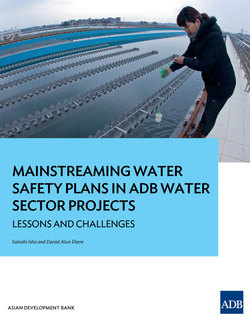Читать книгу Mainstreaming Water Safety Plans in ADB Water Sector Projects - Satoshi Ishii - Страница 5
На сайте Литреса книга снята с продажи.
I. Why Water Safety Plans are Important for ADB Water Projects
ОглавлениеAsia and the Pacific Region is rapidly developing but the region is challenged to manage increasing demand for safe drinking water amidst its fast economic growth and urbanization. By 2010, the world succeeded in meeting the target of Millennium Development Goal 7.C to halve the number of people without access to improved drinking water sources. And additional 2.3 billion more people gained access to improved drinking water sources with the largest gains in eastern, southeastern and south Asian regions between 1990 and 2012.1 However, there is still a significant challenge remains on securing the quality of water throughout its supply system, from water sources to the consumer tap and point of use.
Access to unsafe drinking water entails large economic loss associated to public health. Improving water supply and sanitation, as well as water resource management, could prevent one-tenth of the global disease burden.2 It is well-documented that overall health benefits gained by providing safe water to communities can be many times more than its costs of water safety measures.3 More importantly, waterborne diseases impact the poor the most by exacerbating malnutrition through chronic diarrhea, inhibiting children’s mental development, reducing school attendance, and impeding on the ability and availability of time for economic productivity and basic social functions. The need to purchase medicines to treat the disease also places additional financial burden on household budgets.
Water Safety Plans (WSPs) change the way water supply systems are managed. Traditional drinking water guidelines are reactive, based on infrequent testing that detects contamination only after exposure and fails to completely protect water consumers from harm. In contrast, the WSP, which adopts a preventive approach, tests on frequent—often continuous—process monitoring. Failures are detected early and predefined corrective actions are completed in response to process failures to protect consumers before they are exposed to contamination. Through the preventive approach, the WSP also enables the water service operator to look into the efficiency of its whole water supply system, leading to better overall management for water conservation and quality improvement.
Summary of Key Points
• The World Health Organization (WHO) has been promoting Water Safety Plans (WSPs) since 2004. The WSPs are becoming the international good practice for assessing and managing public health risks from drinking water supplies.
• A key conclusion from the pilot demonstration activity in Chongqing Municipality, People’s Republic of China (PRC) was that WSPs could be effectively integrated into the project preparation of Asian Development Bank (ADB) with careful scoping, planning, and evaluation.
• Lessons from the pilot demonstration activity include selecting appropriate WSP guidance, identifying target water quality, and introducing the WSP concept early in the project.
• Potential challenges for ADB-funded projects are mismatched WSP and project scopes, complex economic and financial evaluations of avoided public health risks, and long-term sustainability of the WSP.
• Various trainings and reference materials are available to address general challenges of WSP implementation. Challenges specific to ADB can only be addressed by accumulating more WSP experience and successful cases in ADB.
The idea is particularly relevant in the rapidly developing Asia and the Pacific Region. Water infrastructure needs to expand to meet widespread need for safe drinking water. Simultaneously, industrial development and population growth are reducing the availability of water resources and deteriorating the quality of existing water supplies. Investment in the Water Financing Program, which ADB launched in 2006, earmarked $10 billion at the end of 2010 and will total over $20–25 billion by the end of 2020 in the region. It is increasingly realized that investment on infrastructure does not readily mean safe drinking water is being delivered to households. It is vital to strengthen the capacity of local water system operators to ensure improved water supply services for the region’s poor is safe and affordable. WSP is a powerful tool to enhance ADB’s project outcome by systematically assessing and managing water safety risks as part of the infrastructure construction and its operation.
